7. Romance and Reality.
Two styles dominated French art in the earlier and middle parts of the 1800s: Romanticism in the earlier years and Realism
in mid-century. France was a world leader in both. The terms are often thought to be opposites—indeed, I proposed the class
on that assumption, but now see the situation is more complicated.
Paris was more or less the epicenter of Romanticism in the earlier 19th century, but much of this was in response to influences
from other countries. French artists did, however, develop a special kind of high-octane Romanticism, in contrast to the more
natural forms found for instance in Germany. Realism, when it occurred, was often a means to achieve a similarly dramatic result,
rather than the more pervasive reality found in French novels later in the century—but those are beyond our scope. rb.
The script, videos, and images will be posted immediately after class.
Here are brief bios of the artists, composers, and writers considered in the class, listed in order of birth.
 |
Anne-Louis Girodet, 1767–1824. French painter.
Girodet was a student of Jacques-Louis David's, and like him spent several years in Italy. His manner is generally more Romantic, however, with a particular interest in evocative lighting effects. In adulthood, he styles himself Girodet-Trioson, in honor of the man who adopted him (and may well have been his natural father).
|
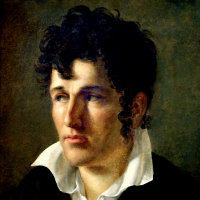 |
François-René de Chateaubriand, 1768–1848. French novelist and statesman.
Though not much remembered today, Chateaubriand dominated the French literary scene at the start of the 19th century, and predates many characteristic features of later Romanticism. Coming from an aristocratic family in Brittany, he eventually went to America to find himself, and spent several months living with indigenous tribes. This experience fueled his stories René and Atala, which attempt to reconcile supposed "primitive" values with his strong Christian faith. From 1814 to 1829, he held various ambassadorships.
|
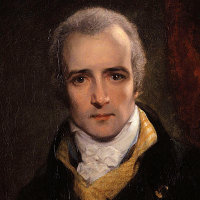 |
Thomas Phillips, 1770–1845. English painter.
Among the leading portraitists in the first decades of the 19th century, Phillips painted artistic figures such as Blake, Byron, and Dibdin, and scientific ones such as Banks, Davy, and Faraday, in addition to the usual complement of politicians and aristocrats.
|
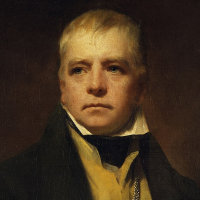 |
Sir Walter Scott, 1771–1832. Scottish poet and novelist.
Scott's historical novels, all set in his native Scotland, spoke to the Romantic spirit and were immensely popular throughout Europe, inspiring many adaptations such as Donizetti's Lucia di Lammermoor.
|
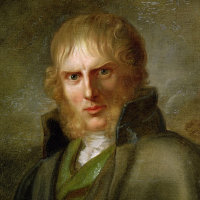 |
Caspar David Friedrich, 1774–1840. German painter.
The greatest German Romantic painter and a truly original visionary, he conceived images based on unconventional views of nature with strong, albeit enigmatic, moral implications.
|
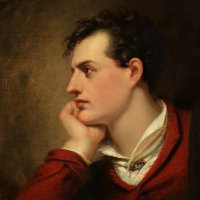 |
George Gordon, Lord Byron, 1788–1824. English poet.
Byron, an hereditary peer, was one of the leading poets of the Romantic age, and the one whose passions and unconventional lifestyle most clearly defined the Romantic Hero, especially among his admirers in France, Germany, and Russia. His long poems Don Juan and Childe Harold's Pilgrimage are epic in scope and show his characteristic combination of action and wit. He died in Greece at the age of 36, fighting in the Greek War of Independence.
|
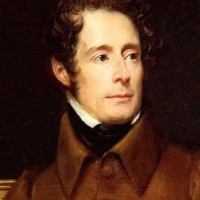 |
Alphonse de Lamartine, 1790–1869. French poet and statesman.
Lamartine achieved instant fame as a poet with his Poetic Meditations of 1820, a collection of lyric verse in a personal vein; his fame quickly spread to America and abroad. First elected a Deputy in 1833, he was an active Republican, becoming Foreign Minister in 1848 and delivering a celebrated speech in defense of the tricolor flag.
|
 |
Théodore Géricault, 1791–1824. French painter.
Géricault's monumental Raft of the Medusa (1819) was a seminal work in French art, treating a contemporary political scandal with searing humanity coupled with a monumentality that owes much to Michelangelo. His many studies for this work, including corpses and severed limbs, his portraits of the insane, and above all his numerous paintings of horses, made him a key figure in French Romanticism until his death from a riding accident at the age of 32.
|
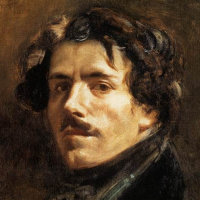 |
Eugène Delacroix, 1798–1863. French painter.
The leading French painter of the Romantic movement, he is known for his brilliant Rubensian color and his dramatic compositions. Especially in the first half of his career, these included political themes, such as The Massacre at Chios (1824) and Liberty Leading the People (1830), as well as subjects from Romantic literature. He also visited North Africa, and was constantly fascinated by the exotic.
|
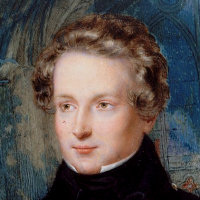 |
Victor Hugo, 1802–85. French writer and politician.
The son of a Napoleonic general, Hugo determined to "become Chateaubriand or nothing." He succeeded, whether as a poet (from 1822), a novelist (The Hunchback of Notre Dame, 1831, and Les Miserables, 1862), and a statesman (senator from 1842). His funeral attracted over two million people.
|
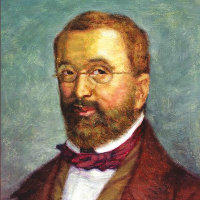 |
Adolphe Adam, 1803–56. French composer.
Adam wrote 39 operas, mainly in the comic vein, but is probably best known for his score to the ballet Giselle (1841).
|
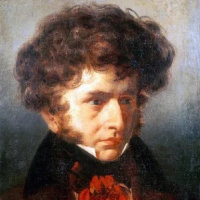 |
Hector Berlioz, 1803–69. French composer, conductor, and critic.
The leading French composer of the Romantic era, Berlioz was a master of orchestration and dramatic effect. A fervent admirer of Shakespeare (and a Shakespearean actress, Harriet Smithson), his works often have a strong literary quality that can obscure their musical craftsmanship. He was unable to get a full performance of his operatic masterpice, The Trojans (1863), but it has come into its own in recent years.
|
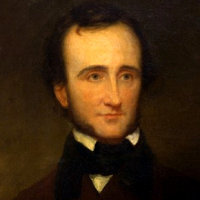 |
Edgar Allan Poe, 1809–49. American writer.
Poe was known for his poetry and especially for his short stories which developed the American Gothic tradition of the macabre and virtually invented the literary mystery. He was also the American author of his time most in tune with European practice, especially in France, where he was very popular. He was, however, continually wrestling with drug addiction, and died at the age of 40.
|
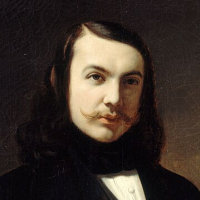 |
Théophile Gautier, 1811–72. French writer.
After his family moved from the Pyrenees to Paris, Gautier grew up among many of the figures who would become part of the artistic scene of the 30s and 40s. He published his first book of poetry in 1830, and soon became known also as a critic. He was a passionate balletomane, and the groundbreaking 1841 ballet Giselle was based on his scenario.
|
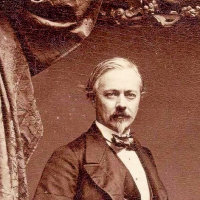 |
Henri Philippoteaux, 1815–84. French painter.
Specializing in military scenes, mostly well in the past, Philippoteux was noted for his large-scale canvases containing numerous figures, including Napoleon's defeat at Waterloo and Lamartine's defense of the French flag. With his son Paul, he painted the huge diorama of the Battle of Gettysburg.
|
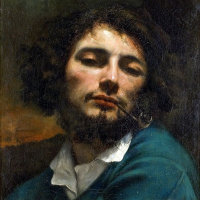 |
Gustave Courbet, 1819–77. French painter.
A fiercely realist painter from the provinces who stood proudly outside the academic tradition, Courbet was nonetheless one of the most powerful figures in 19th-century French art. His vast Burial at Ornans was a succès de scandale at the Salon of 1850, and established him as the leader of the Realist movement.
|
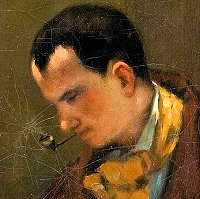 |
Charles Baudelaire, 1821–67. French poet.
Baudelaire is credited with coining the term "modernism," and is held to be the first modernist poet. His masterpiece, the Les fleurs du mal (The Flowers of Evil), which hovers between sensual verse and an exotic kind of prose, was prosecuted as an offence to public morals, and the author was fined. Baudelaire was nonethless a great influence on the next generation of poets, like Verlaine, Rimbaud, and Mallarmé.
|
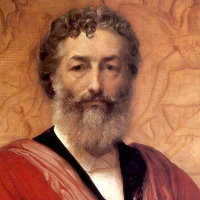 |
Frederick Lord Leighton, 1830–96. English painter.
President of the Royal Academy, and the first painter to be given a peerage, he is one of the dominant figures in Victorian art. He is best known for his colorful and dynamic paintings of Greek mythology.
|
 |
Gustave Doré, 1832–83. French printmaker.
The most celebrated illustrator of the mid-19th century, his fame rests on the romanticism and drama of his treatment of subjects ranging from the Bible to Dante's Inferno and Coleridge's Ancient Mariner.
|
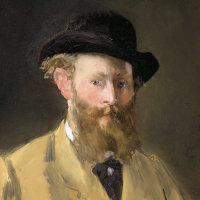 |
Édouard Manet, 1832–83. French painter.
Manet is arguably the greatest French painter in the third quarter of the 19th century. Though primarily a realist, he was influenced by older artists such as Titian and Velasquez. He was admired by the young Impressionists, became friends with Monet, and produced a number of works in their style, but he never exhibited with them, preferring to retain his own status in the official Salons.
|
























































